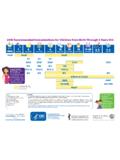Transcription of WHO in 60 years: a chronology of public health …
1 WHO in 60 years: a chronology of public health milestones In 2008, WHO is celebrating its 60th anniversary. The chronology below tells the story of WHO and public health achievements over the last 60 years. 1945: The United Nations Conference in San Francisco unanimously approves the establishment of a new, autonomous international health organization. 1946: The International health Conference in New York approves the Constitution of the World health Organization in July. 1947: The epidemiological information service is established. An automatic telex reply service, it tracks information on diseases subject to the International Sanitary Regulations (later renamed International health Regulations) and other communicable diseases of international importance.
2 1948: The World health Organization Constitution comes into force on 7 April. 1948: The International Classification of Disease - the global standard to report and categorize diseases, health -related conditions and external causes of disease and injury - is published. 1948: Dr Brock Chisholm from Canada is elected as the first Director-General of the World health Organization. 1950: The World health Assembly establishes World health Day to take place annually on 7 April. 1950: Mass TB immunization with the bacille Calmette-Guerin (BCG) vaccine is under way to protect children from tuberculosis.
3 1952: The global yaws control programme is launched in partnership with UNICEF. The programme succeeded in treating 300 million people in 50 countries, reducing global levels of the disease by more than 95%. 1953: Dr Marcolino Gomes Candau of Brazil is elected as the second Director-General of the World health Organization. 1 1955: The Malaria Eradication Programme is launched. Its objective was modified in 1969. Subsequently, most of the malaria eradication programmes were turned into national malaria control programmes. 1958: The World health Assembly initiates the smallpox eradication programme.
4 1963: The oral polio vaccine is licensed. This vaccine was proven to stop person-to-person transmission of wild poliovirus. 1965: The first report on diabetes mellitus is issued. By 2000, 171 million people worldwide carried the disease, a number likely to increase to at least 366 million by 2030. 1965: The International Agency for Research on Cancer is established to coordinate and conduct both epidemiological and laboratory research into the causes of human cancer. 1966: The new headquarters building of the World health Organization in Geneva, Switzerland is inaugurated.
5 1969: The International Sanitary Regulations, endorsed in 1951, are renamed the International health Regulations, specifically covering cholera, plague, smallpox and yellow fever. 1972: To ensure the oral polio vaccine s universal use, its inventor Dr Albert Sabin, donates the rights to the vaccine to the World health Organization. 1973: Dr Halfdan T. Mahler of Denmark is elected as the third Director-General of the World health Organization. 1974: The expanded programme on immunization is launched. Immunization currently averts between 2-3 million deaths every year . 1974: The Onchocerciasis Control Programme is launched in collaboration with the World Bank, the United Nations Development Programme and the Food and Agriculture Organization.
6 1975: The Special Programme for Research and Training in Tropical Diseases is established to help coordinate, support and influence global efforts to combat neglected infectious diseases that disproportionately affect poor and marginalized populations. 1976: The Ebola virus is first identified in the Western Equatorial province of Sudan and in Zaire (now known as the Democratic Republic of the Congo). 1976: The World health Assembly adopts a resolution on Disability Prevention and Rehabilitation calling for an integration of rehabilitation into primary health care programmes and community life.
7 2 1977: The first essential medicines list is published. Today, the list contains 340 medicines that address most global priority conditions, including malaria, HIV/AIDS, tuberculosis, reproductive health and, increasingly, chronic diseases such as cancer and diabetes. 1978: The International Conference on Primary health Care in Alma-Ata (in the former Soviet Union) sets the historic goal of " health for all". 1979: A global commission certifies the worldwide eradication of smallpox. 1986: The Global Programme on AIDS is created to develop and coordinate a global strategy to fight the disease.
8 1988: Dr Hiroshi Nakajima of Japan is elected as the fourth Director-General of the World health Organization. 1988: The World health Assembly endorses a resolution on non-discrimination against people living with AIDS. 1988: The Global Polio Eradication Initiative is established in collaboration with Rotary International, the US Centers for Disease Control and Prevention and UNICEF. 1991: The World health Assembly adopts a resolution to eliminate leprosy. 1995: The International Commission for the Certification of Dracunculiasis Eradication is established. (Dracunculiasis is also known as guinea-worm disease.)
9 1995: The DOTS strategy for TB control is launched, under which 30 million people have been treated to date through primary services. 1996: UNAIDS is created with six founding partner agencies. 1998: Dr Gro Harlem Brundtland of Norway is elected as the fifth Director-General of the World health Organization. 2000: The Stop TB Partnership is launched, hosted by WHO. It now includes over 500 partners working to reduce the global burden of TB by increasing access to treatment through DOTS programmes, and addressing challenges such as TB/HIV and drug-resistant TB. 2000: The Global Outbreak Alert and Response Network is established to detect and combat the international spread of outbreaks.
10 2000: The Commission on Macroeconomics and health is established to assess the impact of health on development. 3 2000: 189 Member States of the United Nations unanimously adopt a Millennium Declaration which results in the Millennium Development Goals. Three out of the eight goals relate directly to health . 2001: The Measles Initiative is launched in partnership with the American Red Cross, UNICEF, the United Nations Foundation and the US Centres for Disease Control and Prevention. As of October 2007, overall global measles deaths have fallen by 68%. 2002: The Global Fund to Fight AIDS, Tuberculosis and Malaria is created to dramatically increase resources to fight three of the world's most devastating diseases.















